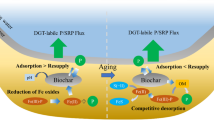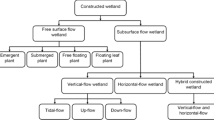Abstract
A long-term study (April 2005 to June 2007) was conducted to assess the seasonal variability in benzene removal by experimental vertical-flow constructed wetlands planted with Phragmites australis (common reeds). The benzene removal efficiency was constant and high (90–100%) during the first year of operation. However, seasonal variability in benzene removal was apparent after January 2006. The highest and lowest benzene removal efficiencies occurred in March and December, respectively. Approximately 8 g (added to the influent every second week) of the slow-releasing N–P–K Miracle-Gro fertiliser was sufficient to treat 1,000 mg/l benzene. Results based on linear regressions indicated that the seasonal benzene removal efficiency was negatively correlated and closely linked to the seasonal effluent dissolved oxygen and NO3–N concentrations, whilst positively correlated and closely linked to the seasonal effluent pH and redox values. Temperature and effluent NH4–N and PO4 3−P concentrations were weakly linked to seasonal benzene removal efficiencies.








Similar content being viewed by others
References
Adachi, A., Ikeda, C., Takagi, S., Fukao, N., Yoshie, E., & Okano, T. (2001). Efficiency of rice bran for removal of organochlorine compounds and benzene from industrial wastewater. Journal of Agricultural and Food Chemistry, 49(3), 1309–1314. doi:10.1021/jf001147c.
Ahn, C. H. (1999). The characteristics of crude oil biodegradation in sand columns under tidal cycles. MSc thesis, University of Cincinati, Cincinati.
APHA. (1998). Standard methods for the examination of water and wastewater, 20th ed. Washington, DC: American Public Health Association, American Water Works Association and Water Environment Federation.
Aronson, D., & Howard, P. H. (1997). Anaerobic biodegradation of organic chemicals in groundwater: A summary of field and laboratory studies. New York: Environmental Science Center.
Burland, S. M., & Edwards, E. A. (1999). Anaerobic benzene biodegradation linked to nitrate reduction. Applied and Environmental Microbiology, 65(2), 529–533.
Cannon, A. D., Gray, K. R., Biddlestone, A. J., & Thayanithy, K. (2000). Pilot-scale development of a bioreactor for the treatment of dairy dirty water. Journal of Agricultural Engineering Research, 77(3), 327–334. doi:10.1006/jaer.2000.0595.
Choi, S. C., & Oh, Y. S. (2002). Simultaneous removal of benzene, toluene and xylenes mixture by a constructed microbial consortium during biofiltration. Biotechnology Letters, 24(15), 1269–1275. doi:10.1023/A:1016273828254.
Coates, J. D., Bruce, R. A., & Haddock, J. D. (1998). Anoxic bioremediation of hydrocarbons. Nature, 396(6713), 730. doi:10.1038/25470.
Coates, J. D., Chakraborty, R., Lack, J. G., O’Connor, S. M., Cole, K. A., Bender, K. S., & Achenbach, L. A. (2001). Anaerobic benzene oxidation coupled to nitrate reduction in pure culture by two strains of Dechloromonas. Nature, 411(6841), 1039–1043. doi:10.1038/35082545.
Cooney, J. (1984). The fate of petroleum pollutants in freshwater ecosystems. In R. M. Atlas (Ed.), Petroleum microbiology (pp. 399–433). New York: Macmillan.
Corley, T. L., Farrell, J., Hong, B., & Conklin, M. H. (1996). VOC accumulation and pore filling in unsaturated porous media. Environmental Science & Technology, 30(10), 2884–2891. doi:10.1021/es950644k.
Descousse, A., Monig, K., & Voldum, K. (2004). Evaluation study of various produced-water treatment technologies to remove dissolved aromatic components. Society of Petroleum Engineers (SPE) Annual Technical Conference and Exhibition (26–29 September 2004), Paper SPE 90103. Houston: SPE.
Dou, J., Liu, X., Hu, Z., & Deng, D. (2008). Anaerobic BTEX biodegradation linked to nitrate and sulfate reduction. Journal of Hazardous Materials, 151(2–3), 720–729. doi:10.1016/j.jhazmat.2007.06.043.
García, J., Aguirre, P., Mujeriego, R., Huang, Y. M., Ortiz, L., & Bayona, J. M. (2004). Initial contaminant removal performance factors in horizontal flow reed beds used for treating urban wastewater. Water Research, 38(7), 1669–1678. doi:10.1016/j.watres.2004.01.011.
Gibson, D. T., & Subramanian, V. (1984). Microbial degradation of aromatic hydrocarbons. In D. T. Gibson (Ed.), Microbial degradation of organic compounds (pp. 181–252). New York: Marcel Dekker.
Görgényi, M., Dewulf, J., & Langenhove, H. V. (2002). Temperature dependence of Henry’s law constant in an extended temperature range. Chemosphere, 48(7), 757–762. doi:10.1016/S0045-6535(02)00131-5.
Granger, D. A., Butler, B. J., & Barker, J. F. (1999). A case of phosphorus limiting monoaromatic hydrocarbon biodegradation in groundwater. Bioremediation Journal, 3(3), 213–221. doi:10.1080/10889869991219325.
Harwood, C. S., & Gibson, J. (1997). Shedding light on anaerobic benzene ring degradation: A process unique to prokaryotes? Journal of Bacteriology, 179(2), 301–309.
Holder, A. W., Bedient, P. B., & Hughes, J. B. (1999). Modeling the impact of oxygen reaeration on natural attenuation. Bioremediation Journal, 3(2), 137–149. doi:10.1080/10889869991219451.
Höhener, P., Duwig, C., Pasteris, G., Kaufmann, K., Dakhel, N., & Harms, H. (2003). Biodegradation of petroleum hydrocarbon vapors: laboratory studies on rates and kinetics in unsaturated alluvial sand. Journal of Contaminant Hydrology, 66(1–2), 93–115. doi:10.1016/S0169-7722(03)00005-6.
Hu, Z. F., Dou, J. F., Liu, X., Zheng, X. L., & Deng, D. (2007). Anaerobic biodegradation of benzene series compounds by mixed cultures based on optional electronic acceptors. Journal of Environmental Sciences (China), 19(9), 1049–1054. doi:10.1016/S1001-0742(07)60171-5.
International Association of Oil and Gas Producers. (2002). Aromatics in produced water: Occurrence, fate and effects, and treatment. International Association of Oil and Gas Producers, London. Retrieved 10 September 2008 from http://www.ogp.org.uk/pubs/324.pdf.
Ji, G. D., Sun, T. H., & Ni, J. R. (2007). Surface flow constructed wetland for heavy oil-produced water treatment. Bioresource Technology, 98(2), 436–441. doi:10.1016/j.biortech.2006.01.017.
Johnson, S. J., Woolhouse, K. J., Prommer, H., Barry, D. A., & Christofi, N. (2003). Contribution of anaerobic microbial activity to natural attenuation of benzene in groundwater. Engineering Geology, 70(3–4), 343–349. doi:10.1016/S0013-7952(03)00102-9.
Jung, I. G., & Park, C. H. (2004). Characteristics of Rhodococcus pyridinovorans PYJ-1 for the biodegradation of benzene, toluene, m-xylene (BTX), and their mixtures. Journal of Bioscience and Bioengineering, 97(6), 429–431.
Keefe, S. H., Barber, L. B., Runkel, R. L., & Ryan, J. N. (2004). Fate of volatile organic compounds in constructed wastewater treatment wetlands. Environmental Science & Technology, 38(7), 2209–2216. doi:10.1021/es034661i.
Kniemeyer, O., Fischer, T., Wilkes, H., Glockner, F. O., & Widdel, F. (2003). Anaerobic degradation of ethylbenzene by a new type of marine sulfate-reducing bacterium. Applied and Environmental Microbiology, 69(2), 760–768. doi:10.1128/AEM.69.2.760-768.2003.
Knight, R. L., Kadlec, R. H., & Ohlendorf, H. M. (1999). The use of treatment wetlands for petroleum industry effluents. Environmental Science & Technology, 33(7), 973–980. doi:10.1021/es980740w.
Lee, B.-H., & Scholz, M. (2006). A comparative study: prediction of constructed treatment wetland performance with K-nearest neighbours and neural networks. Water, Air, and Soil Pollution, 174(1–4), 279–301. doi:10.1007/s11270-006-9113-2.
Lee, J. F., Chao, H. P., Chiou, C. T., & Manes, M. (2004). Turbulence effects on volatilization rates of liquids and solutes. Environmental Science & Technology, 38(16), 4327–4333. doi:10.1021/es0353964.
Li, H., Liu, Y. H., Luo, N., Zhang, X. Y., Luan, T. G., Hu, J. M., Wang, Z. Y., Wu, P. C., Chen, M. J., & Lu, J. Q. (2006). Biodegradation of benzene and its derivatives by a psychrotolerant and moderately haloalkaliphilic Planococcus sp. strain ZD22. Research in Microbiology, 157(7), 629–636. doi:10.1016/j.resmic.2006.01.002.
Lu, C., Lin, M. R., & Chu, C. (2002). Effects of pH, moisture, and flow pattern on trickle-bed air biofilter performance for BTEX removal. Advances in Environmental Research, 6(2), 99–106. doi:10.1016/S1093-0191(00)00072-1.
Mitsch, W. J., & Gosselink, J. G. (1993). Wetlands. New York: Van Nostrand Reinhold.
Mueller, J. G., Resnick, S. M., Shelton, M. E., & Pritchard, P. H. (1992). Effect of inoculation on the biodegradation of weathered Prudhoe Bay crude oil. Journal of Industrial Microbiology & Biotechnology, 10(2), 95–102.
Pritchard, P. H., Mueller, J. G., Rogers, J. C., Kremer, F. V., & Glaser, J. A. (1992). Oil spill bioremediation: Experiences, lessons and results from the Exxon Valdez oil spill Alaska. Biodegradation, 3(2–3), 109–132. doi:10.1007/BF00129091.
Purandare, J. A. (1999). Bioremediation of oil-contaminated freshwater wetlands. MSc thesis, University of Cincinnati, Cincinnati.
Rosenberg, E., & Ron, E. Z. (1996). Bioremediation of petroleum contamination. In R. L. Crawford, & D. L. Crawford (Eds.), Bioremediation: Principles and applications (pp. 100–124). Cambridge: Cambridge University Press.
Salmon, C., Crabos, J. L., Sambuco, J. P., Bessiere, J. M., Brasseres, A., Caumette, P., & Baccou, J. C. (1998). Artificial wetland performances in the purification efficiency of hydrocarbon wastewater. Water, Air, and Soil Pollution, 104(3–4), 313–329. doi:10.1023/A:1004928009345.
Scholz, M. (2006). Wetland systems to control urban runoff. Amsterdam: Elsevier.
Scholz, M. (2007). Classification methodology for sustainable flood retention basins. Landscape and Urban Planning, 81(3), 246–256. doi:10.1016/j.landurbplan.2007.01.010.
Scholz, M., Höhn, P., & Minall, R. (2002). Mature experimental constructed wetlands treating urban water receiving high metal loads. Biotechnology Progress, 18(6), 1257–1264. doi:10.1021/bp0200503.
Schreiber, M. E., & Bahr, J. M. (2002). Nitrate-enhanced bioremediation of BTEX-contaminated groundwater: Parameter estimation from natural-gradient tracer experiments. Journal of Contaminant Hydrology, 55(1–2), 29–56. doi:10.1016/S0169-7722(01)00184-X.
Spence, J. M., Bottrell, S. H., Thornton, S. F., Richnow, H. H., & Spence, K. H. (2005). Hydrochemical and isotopic effects associated with petroleum fuel biodegradation pathways in a chalk aquifer. Journal of Contaminant Hydrology, 79(1–2), 67–88. doi:10.1016/j.jconhyd.2005.06.003.
Venosa, A. D., & Zhu, X. (2003). Biodegradation of crude oil contaminating marine shorelines and freshwater wetlands. Spill Science & Technology Bulletin, 8(2), 163–178. doi:10.1016/S1353-2561(03)00019-7.
Vymazal, J. (2007). Removal of nutrients in various types of constructed wetlands. The Science of the Total Environment, 380(1–3), 48–65. doi:10.1016/j.scitotenv.2006.09.014.
Ward, D. M., & Brock, T. D. (1976). Environmental factors influencing the rate of hydrocarbon oxidation in temperate lakes. Applied and Environmental Microbiology, 31(5), 764–772.
Wrenn, B. A., Haines, J. R., Venosa, A. D., Kadkhodayan, M., & Suidan, M. T. (1994). Effects of nitrogen source on crude oil biodegradation. Journal of Industrial Microbiology & Biotechnology, 13(5), 279–286.
Xu, R., Obbard, J. R., & Tay, E. T. C. (2003). Optimization of slow-release fertilizer dosage for bioremediation of oil-contaminated beach sediment in a tropical environment. World Journal of Microbiology & Biotechnology, 19(7), 719–725. doi:10.1023/A:1025116421986.
Yang, S., Yoshida, N., Baba, D., & Katayama, A. (2008). Anaerobic biodegradation of biphenyl in various paddy soils and river sediment. Chemosphere, 71(2), 328–336. doi:10.1016/j.chemosphere.2007.09.002.
Ye, S. H., Huang, L. C., Li, Y. O., Ding, M., Hu, Y. Y., & Ding, D. W. (2006). Investigation on bioremediation of oil-polluted wetland at Liaodong Bay in northeast China. Applied Microbiology and Biotechnology, 71(4), 543–548. doi:10.1007/s00253-005-0165-9.
Yeom, S. H., & Yoo, Y. J. (1999). Removal of benzene in a hybrid bioreactor. Process Biochemistry, 34(3), 281–288. doi:10.1016/S0032-9592(98)00094-6.
Yerushalmi, L., & Guiot, S. R. (2001). Biodegradation of benzene in a laboratory-scale biobarrier at low dissolved oxygen concentrations. Bioremediation Journal, 5(1), 63–77. doi:10.1080/20018891079195.
Acknowledgements
Mr. Xianqiang Tang received a PhD scholarship from the China Scholarship Council, National Natural Science Foundation of China (no. 50479034). He is a PhD student at Nankai University as well as a visiting PhD student at The University of Edinburgh. The authors wish to acknowledge further funding received from the first and second Executive Governor of Ebonyi State (Dr. Sam Egwu), Prof. Ozo N. Ozo and from the Petroleum Technology Development Fund (Nigeria) for Mr. Paul Eke’s PhD study. Dr Scholz is a Visiting Professor at Nankai University. The technical assistance of various visiting researchers and final year project students is acknowledged.
Author information
Authors and Affiliations
Corresponding author
Rights and permissions
About this article
Cite this article
Tang, X., Eke, P.E., Scholz, M. et al. Seasonal Variability in Benzene Removal by Vertical-Flow Constructed Wetland Filters. Water Air Soil Pollut 202, 259–272 (2009). https://doi.org/10.1007/s11270-008-9974-7
Received:
Accepted:
Published:
Issue Date:
DOI: https://doi.org/10.1007/s11270-008-9974-7




